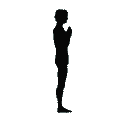| lilly
Site Admin
| | Joined: 25 Aug 2005 | | Posts: 196 | |
|
 Posted: Fri Oct 10, 2008 11:37 pm Post subject: Kapalabhati Pranayam- breathing exercise Posted: Fri Oct 10, 2008 11:37 pm Post subject: Kapalabhati Pranayam- breathing exercise |
 |
|
Kapalabhati Pranayam
http://myblogonbeauty.blogspot.com/2006/12/kapalabhati-pranayam.html
Kapalabhati’ Pranayam breathing exercise is an excellent way of maintaining good health and fighting diseases. ‘Kapala’ means ‘skull’ (and ‘forehead’ also) and ‘bhati’ means ‘shining’. By doing kapalabhati, the ‘nadis’(nerves) of the brain get good exercise. This is achieved by exercising the diaphragm. There will be a glow on the forehead. After the age of 25, the tell-tale signs of ageing start making their appearance in the form of fine lines on the forehead. A regular practice of Kapalabhati for 10-15 minutes everyday will give you a tight forehead sans wrinkles for many years to come. Why resort to botox injections and other expensive chemical or surgical procedures to get rid of your age lines, when there is such a simple and natural alternative available to you in the form of ‘Kapalabhati’. This pranayam will not only improve your overall health but also gift you with a luminous forehead and a glowing skin. Read about the bad-effects of botox injections at BBC Health. All you have to do is to spare a few minutes everyday and practise this amazing breathing exercise, which Swami Ramdev calls as ‘Dharti ki sanjivani’ (the world’s miracle cure for diseases.) Read about anulom-vilom pranayam, Sitali and Sitkari Pranayams and Bhramari Pranayam also.
Procedure:
Sit in a comfortable pose preferably in Padmasana(lotus pose). Those who are unable to sit in any suitable asana can sit on a suitable chair, keeping the head and spine erect. Concentrate on the tip of your nose. Exercise the diaphragm by exhaling suddenly and quickly. This process consists of two actions – Rechaka (exhaling) and Puraka (inhaling). In Rechaka, the main and important part is sudden exhaling and in Puraka, inhaling is automatic and passive. In Rechaka, all the air should be exhaled out of the lungs by sudden and vigorous inward stroke of the front abdominal muscles. Let the abdominal stroke be complete and let the breath flow out fully. In Puraka no willful expansion of the muscles is necessary and the abdominal muscles are also kept relaxed. In short, breathe in normally and breathe out forcefully, so as to influence the organs of the abdominal area.
Important note:
Early morning or early evening is the best times to practise. In the morning, practise before breakfast and half an hour after a glass of fruit juice or a cup of tea. Try to empty your bladder and bowel before you begin. Never practise after a meal. Wait an hour after a snack or light meal, three hours after a heavy one. Though this exercise is permissible when you are having your periods, avoid it during pregnancy.
Duration
Start doing this with 20 to 30 strokes in a minute. Relax, when you feel tired. After a month or two, you will be able to do it continuously for 5 minutes at a stretch. You may do this exercise for 10-15 minutes, resting after every 5 minutes. Do not hurry, struggle or strain. If you feel tired, rest for a while and resume. Throughout the practice of Kapalabhati, the thorax muscles are kept contracted. Watch Swami Ramdev doing it here.
Caution:
Do this pranayam only under proper guidance from a competent yoga guru. Also have a look at Kapalabhati- the breath of fire
Advantages:
Persons doing Kapalabhati will be inhaling a good amount of oxygen which purifies the blood and in turn strengthens the nervous and brain centres. It also gives good massage to the internal abdominal organs. Incorporating Anulom Vilom Pranayam and Kapalabhati breathing exercises in your daily exercise regimen not only cures chronic diseases but also strengthens your immune system, thus, warding off many diseases. Those suffering from diabetes, cardiovascular diseases, obstinate skin diseases, high blood pressure, obesity, chronic depression, constipation, flatulence, menstrual problems, kidney diseases, respiratory problems, allergies, sinus etc. have benefited tremendously from a regular practice of Kapalabhati pranayam.
In one of Swami Ramdev’s yoga workshops telecast on Aastha TV, a woman was relating how she lost 15 kilos within a year by regularly doing kapalbhati. Another woman who had leucoderma, narrated how her white patches reduced by about 60% within 3-4 months of her practice of this pranayama. She good humouredly remarked that many people after seeing the drastic change in the color and texture of her skin were wondering whether her husband had remarried. She even showed her old photographs to substantiate her claim. These two narrations are still vivid in my memory; there were many more who related their experiences about how it cured them of diabetes, throat cancer, asthma, depression etc. They even submitted their medical records in the presence of all.
Have you ever observed people having a hearty laugh? Belly laughter expels more air from the lungs, than you take in, almost replicating kapalabhati. That’s why laughter is so good for health.     
Lilly  |
|








